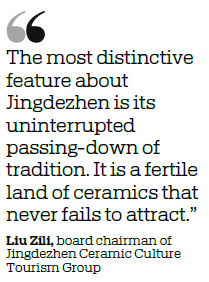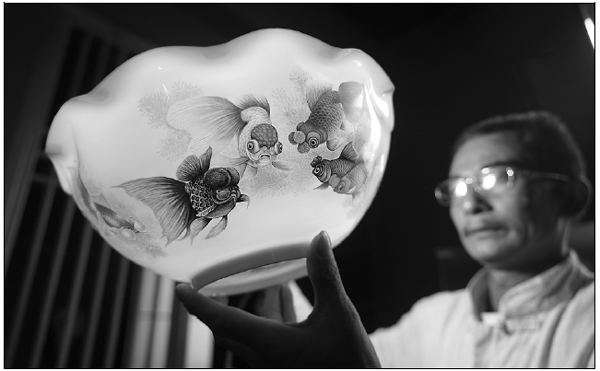City of ceramics fires up passion for conservation
Jingdezhen looks to its proud heritage of pottery masters to ensure cultural future
JINGDEZHEN, Jiangxi - Silver-haired foremen place blocks of pinewood into a burning kiln, stoking them to up the flames. They wait for lumps of clay fashioned and molded by careful hands, to turn into translucent porcelain. Drinking hot cups of tea to pass the time, they remain vigilant overnight. It can take days for a kiln to work its magic.
Jingdezhen, known as the capital of ceramics, is a small city in the mountains of East China's Jiangxi province. Today, it hosts both tradition and change, drawing people from the East and the West.
The senior foremen took part in a ceremonial re-burning of a centuries-old, gourd-shaped kiln. The ceremony was a big event at the 2019 China Jingdezhen International Ceramic Fair, its 16th annual session. The fair attracts thousands of porcelain masters, students, artists and entrepreneurs every year. It closed last week.
Jingdezhen's history of ceramic-making dates back more than 2,000 years. Its role as an official and royal kiln pushed its porcelain-making techniques into history. However, as the dynastic system fell, the city entered a low ebb artistically and economically.
In the 1990s, the city of prestigious craftsmanship was overshadowed by industrial production lines.

In recent decades, Jingdezhen has reshaped its image. This month, a national ceramic culture inheritance and innovation pilot zone threw a spotlight on the city. The city is now considering new projects in conservation, innovation, cultural tourism and exchanges.
Living tradition
Cheng Guanghui, 65, is one of the kiln fire masters. Most porcelains are now made in gas-fired kilns, though a handful of firewood-stoked kilns exist in the city suburbs. For Cheng, refiring old kilns is critical.
"If we do not fire up the old kilns, the heritage will die in our hands," he said. People favor gas kilns because they are easy, fast and guarantee consistent quality. But Cheng said the firewood kilns produce porcelains that are less predictable and have their own character.
Jingdezhen's conservation of tradition has been a success. From 2009, 10 ancient kilns have been re-burned.
In the heart of Jingdezhen, a royal kiln remains the soul of the city. Royal mandate demanded the best quality. "Royal kilns made porcelain regardless of cost. Workers usually made four to 10 copies, but only shipped the best one to the emperor and smashed the rest. So, to this day, we have thick layers of potsherds in the ground," said Fu Hongsong, a guide of the royal kiln site.
In the surrounding areas, a large-scale project is underway. Over the next five years, dilapidated houses in a 13-square-kilometer area will be restored. The project is expected to cost around 5 billion yuan ($707.71 million), said Liu Zili, board chairman of Jingdezhen Ceramic Culture Tourism Group, a State-owned company.
"We need to protect the physical space of history because there is a tremendous amount of information in it. And we need to pass down our cultural heritage, because that is the soul of the city," Liu said.
Culture shared
Liu, in his 50s, describes Jingdezhen as a city of migrants. His father came to Jingdezhen from Hunan province in the 1950s. "The most distinctive feature about Jingdezhen is its uninterrupted passing-down of tradition. It is a fertile land of ceramics that never fails to attract," he said.
According to government statistics, about 150,000 people, roughly one-fourth of the city's downtown population, work in the porcelain industry. Every year, about 30,000 migrants live in the city, including 5,000 from overseas.
Jiao Mengtian lived in the United States for several years before coming to Jingdezhen. "When I began to develop an interest in ceramics, I thought I should come to see its origin," he said.
Jingdezhen has drawn up plans for building a pilot zone to attract experts from both home and abroad, said Chen Ying, an official with the city's talent bureau.
"Talent will have to be the main driving force if Jingdezhen is to move ahead, so the city is putting a lot of effort into this," he said.
At the city's landmark Taoxichuan, an industrial heritage complex, about 200 overseas pottery artists presented their pieces during the autumn fair.
The redbrick buildings have served as an incubator for aspiring students, artists, entrepreneurs and merchants. In 2018, Taoxichuan reported 101 million yuan in revenue, up 36 percent year-on-year.
International perspective
Jingdezhen was once a symbol of worldwide trade and it is ready to assume a bigger role in international cultural exchange.
Blue and white porcelain is the signature design of Jingdezhen. At the expo, Simon van Oosten from Delft, the Netherlands showed off his painting skills. In the 17th century, with the arrival of porcelain from China, workers in Delft began experimenting with the blue and white patterns.
"Even today, the level of skill of the Chinese porcelain makers is very impressive," said Oosten, head of decoration of Heinen Delfts Blauw, a Dutch porcelain company.
Xinhua
|
A master porcelain craftsman from Jingdezhen, Jiangxi province, which is dubbed the capital of ceramics, holds up one of his works. Zhou Mi / Xinhua |
(China Daily 10/31/2019 page17)















